Departmental news
Lord Bhattacharyya Award winner announced
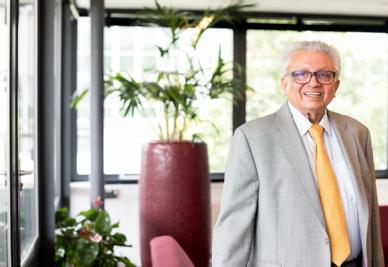 The Royal Academy of Engineering and WMG, at the University of Warwick, have announced the University of Surrey’s 5G Innovation Centre (5GIC) as the first ever winner of the Bhattacharyya Award.
The Royal Academy of Engineering and WMG, at the University of Warwick, have announced the University of Surrey’s 5G Innovation Centre (5GIC) as the first ever winner of the Bhattacharyya Award.
The Award, which carries a £25,000 prize, has been presented in recognition of an exemplary academia-industry partnership that has helped to build the UK’s work in 5G technology from the ground up, and produced world-leading innovation in the field.
The Bhattacharyya Award is funded by the Department for Business, Energy and Industrial Strategy and was created to encourage more private and academic entities to collaborate, as a tribute to the late Professor Lord Kumar Bhattacharyya KT CBE FREng FRS, Regius Professor of Manufacturing at the University of Warwick and founder of WMG.
Margot James, Executive Chair at WMG, University of Warwick, said: “This partnership exemplifies innovative academia-industry collaboration, for which Professor Lord Bhattacharyya was a keen advocate. He believed in effective industrial strategy, with a focus on the impact of research and training and technology partnerships between industry and universities. This inaugural Lord Bhattacharyya Award will inspire the next generation of academics and industry experts to come together to create more ground-breaking research.”
Surrey’s 5GIC has built collaborations with more than 27 global industrial partners and over 300 UK SMEs since its launch in 2013, bringing together leading academics and companies to help develop the 5G infrastructure that will underpin the way we communicate, work and live our everyday lives. 5G technology is estimated to be worth up to £173 billion to the UK economy by 2030, increasing productivity, driving modernisation and enabling transformative applications in automation, healthcare, manufacturing, self-driving vehicles, and remote robotics. Its evolution to 6G is set to address grand societal and industrial challenges, such as the digital divide, and privacy, as well as support efforts towards achieving the net-zero national agenda.
Regius Professor Rahim Tafazolli, Head of the Institute for Communication Systems (ICS) at the University of Surrey and Founder and Director of the 5GIC, said: “Collaboration with industry partners is at the heart of our achievements. The challenge of 5G could not be met without the close cooperation of major businesses with academia, and realising the benefits of the new technology by reaching out to regional communities and SMEs.
“We will use the Bhattacharyya Award funding to expand our overseas relationships – particularly with South Korea and Japan – and maintain our international profile. We will also use the prize to provide collaborative industry opportunities for training, knowledge exchange, and skills development for early careers researchers. All of these activities will be co-developed with industry to ensure that they meet the future needs of the UK and global workforce. We feel that this boost to skills development is particularly important to help offset the disruption caused by the pandemic.”
Science Minister Amanda Solloway said: “I am delighted to see the first Bhattacharya Award go to the University of Surrey’s 5G Innovation Centre (5GIC), whose work to bolster the UK’s competitiveness in 5G technology has already helped to attract nearly £100m of industry funding.
“5GIC puts collaboration between industry and academia at the core of its work, and I hope this award inspires other researchers, academics and industry experts to join forces as part of our efforts to build back better from the pandemic.”
Professor Dame Ann Dowling OM DBE FREng FRS, immediate past-President of the Royal Academy of Engineering, is chair of the judging panel for the Bhattacharyya Award. She said: “Had companies been working individually and with more limited collaboration with academia, these outputs and outcomes would have taken far longer to achieve. The collaborative work at 5GIC is enabling the UK to be a leader in the international competition. The Bhattacharyya Award aims to transform how universities research and educate to meet the needs of industry and society, which is exactly what the University of Surrey’s 5GIC has done, and we congratulate the team for setting such a high bar in this first cycle of the Award.”
Consortium established to tackle decarbonisation of cross-Channel ferry fleet
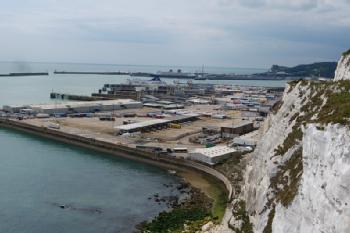 WMG at the University of Warwick is playing a key part in a new research project supporting the UKs pledge to achieve net-zero by 2050.
WMG at the University of Warwick is playing a key part in a new research project supporting the UKs pledge to achieve net-zero by 2050.
The seven-month project, entitled the Dover Clean Ferry Power, is a collaboration between the Port of Dover, P&O Ferries, WMG and Schneider Electric, led by Kent Business School at the University of Kent.
The project, which is part of a £20 million programme funded by the Department for Transport, will investigating the decarbonisation of the cross-Channel ferry fleet and in turn support the delivery of the Port of Dover Air Quality Action Plan.
Currently, Port of Dover vessels spend energy through in-harbour activity, open sailing and on-vessel services (such as heating, lighting and hospitality). Some vessels are hybrid; self-charging on-board batteries whilst in open sailing and then using the battery charge whilst in-harbour.
This project will model ferry operations at Dover to establish energy requirements, CO2 effects, air quality and running costs, using this to evaluate technical solutions for both ferries and the port, to accelerate the move to net zero. Insights gained may then have the potential to extend to cruise and cargo operators, as well as adaptation of experienced vessels.
Researchers and engineers at WMG High Value Manufacturing Catapult Centre will be undertaking all of the battery modelling and analytics, plus energy and CO2 modelling for the port of Dover and for vessels using the port– which will impact the locals as well as the environment more widely.
Phil Whiffin, WMG Head of Energy Applications Group, explains: “This project builds on our existing zero emission transport expertise and allows us to apply the MIMO (Multi-Input Multi-Output) modelling technique developed by Dr Andrew McGordon to investigate the complex operations of a port. It will support investment and operation decisions for Dover and the ferry operators and ensure the optimum strategy is in place to move towards net-zero. Dover is an essential trade gateway for the UK so this is a project of great strategic importance and we are pleased to be part of this great consortium.”
Simon Barnes, Project Manager and Funding & Partnership Development Manager within the University of Kent’s Research & Innovation Operations, said: ‘For the University of Kent, this new project builds on a previous successful work with the Port of Dover and is an excellent example of a collaborative project with the University, industry partners and consumers.
‘It is our unified aim to investigate potential avenues that can lead to reductions in carbon emissions as part of the national priority of net-zero. The University of Kent is dedicated to the endeavour through a series of initiatives, with the Dover Clean Ferry Power project as a prime example of the role we play regionally and in applying intensive research to vital national goals.’
ENDS
Notes to Editors
(1)
Clean Maritime Demonstration Competition
The Dover Clean Ferry Power Project is part of the Clean Maritime Demonstration Competition, funded by the Department for Transport and delivered in partnership with Innovate UK.
Announced in March 2020, and part of the Prime Minister’s Ten Point Plan to position the UK at the forefront of green shipbuilding and maritime technology, the Clean Maritime Demonstration Competition is a £20m investment from government alongside a further c.£10mfrom industry to reduce emissions from the maritime sector. The programme is supporting 55 projects across the UK, including projects in Scotland, Northern Ireland and from the South West to the North East of England. As set out in the Clean Maritime Plan (2019), Government funding has been used to support early-stage research relating to clean maritime. The programme will be used to support the research, design and development of zero emission technology and infrastructure solutions for maritime and to accelerate decarbonisation in the sector.
China welcomes world’s largest scenario database for autonomous vehicle safety
- Safety Pool™, led by WMG at the University of Warwick and Deepen AI, launches major collaboration with Automotive Data of China (CATARC-ADC), a subsidiary of CATARC Co., Ltd, bringing world’s largest public database for testing autonomous vehicle safety to China
- The database provides diverse sets of road safety scenarios, so that autonomous vehicles can be rigorously tested on virtual simulations of real public routes – this will now include Chinese use cases
- Over 200 organisations worldwide have already enrolled in Safety Pool™; greater collaboration advances the autonomous vehicle industry and further enhances road safety globally
The Safety PoolTM Scenario Database, the largest public repository of scenarios for testing autonomous vehicles in the world — led by WMG at the University of Warwick and Deepen AI — will now be used in China, thanks to a new partnership with Automotive Data of China, a subsidiary of the China Automotive Technology and Research Center (CATARC-ADC).

CATARC-ADC is China’s principal research and technical organisation for the automotive industry, and is at the cutting edge of the country’s innovation and regulation for connected and autonomous vehicles (CAV). Meanwhile, CATARC-ADC actively participates in ISO, ASAM and UNECE and other international organizations, with international influence.
This significant new major collaboration, launched today (9 September 2021), means that Safety Pool™ Scenario Databases will enable road simulations including use cases from China, broadening the scope of this global safety platform – thus supporting the growing CAV industry, informing emerging regulatory policies, and enhancing the safety of millions more drivers across China and beyond.
Dr Siddartha Khastgir, Head of Verification & Validation, Intelligent Vehicles at WMG, University of Warwick, said:
“Safety of Autonomous Vehicles needs to be a collaborative mission. No one organisation or country can achieve this mission on their own. With this in mind we created Safety PoolTM Scenario Database to enable global collaboration on scenario sharing.
We are delighted that CATARC-ADC have joined Safety PoolTM Scenario Database which reinforces our mission of international collaboration on CAV safety. With a diverse set of scenarios, the database caters to a large number of autonomous vehicle applications, many of which will be relevant for our stakeholders in China.”
 Nicola Croce, Technical Program Manager, Deepen AI, said:
Nicola Croce, Technical Program Manager, Deepen AI, said:
“Safety Pool™ has all the ingredients to be the reference platform and initiative for AV safety assurance worldwide. What's very unique about it is its global scope, the incentive-based mechanisms engineered to attract and provide value to every different industry stakeholder, and the deep engagement with regulators, everything based on a common foundation of data sharing.
We are excited to welcome CATARC-ADC to the Safety Pool initiative. CATARC-ADC is the major player in scenario-based testing and scenario databases in China. CATARC-ADC’s entry into Safety Pool™ provides a key stepping stone in international collaborations in the scenario-based testing landscape of AVs, and a major leap forward to help companies improve their adaptability in China-oriented testing for ADS.”
Since the launch of this pioneering project in March 2021, WMG at the University of Warwick and Deepen AI have collaborated with stakeholders around the world: to date, over 200 organisations have enrolled in the Safety PoolTM Scenario Database
Bolin Zhou, Global Business General Manager, CATARC – ADC said:
“As a founding member of Safety PoolTM Scenario Database in China and the leading third-party company for ADS validation in China, Automotive Data of China will use the great opportunity of Safety PoolTM Scenario Database to tackle the global autonomous vehicle safety issues with its own strength. Safety PoolTM Scenario Database is a crucial, open platform that aligns well with ADC positioning in China and around the world. Through Safety PoolTM Scenario Database, a global safety tool, China will continue to provide data and tool services for automated driving system validation”
Tim Dawkins, Global Impact Strategy Lead, World Economic Forum said:
“Initiatives like Safety Pool are key to making safe autonomous vehicles a reality – we should not be making safety a competitive advantage. This shared scenario library will allow developers to learn from one another’s datasets to increase the robustness of their systems through exposure to a diverse scenario set. CATARC’s support for Safety Pool represents a vital commitment to a level playing field for the development of autonomous vehicles in the name of safety”
Richard Morris, Innovation Lead - Autonomous & Connected Vehicles, Innovate UK said:
“Innovate UK is glad to have supported the creation and the development of the Safety PoolTM Scenario Database. We would also like to encourage more organisations and countries to contribute scenario content. Scenarios kept in private siloes will not help the mass acceptance of vehicle automation. We all need to share safety knowledge and make best practice widely available. The more comprehensive the Safety PoolTM Scenario Database becomes, the more useful it is for any developer wanting to deploy CAVs anywhere around the world.”
The database provides a diverse set of scenarios in different operational design domains (ODDs i.e. operating conditions) that can be leveraged by governments, industry and academia alike to test and benchmark Automated Driving Systems (ADSs) and use insights to inform policy and regulatory guidelines.
The scenarios have been generated using a novel hybrid methodology developed by WMG, at the University of Warwick, using both knowledge-based and data-based approaches. The Safety Pool™ Scenario Database allows organisations to create scenarios in their own libraries, collaborate with other organisations via both shared and public libraries and enable the public to submit challenging real-world scenarios.
Enabling scenarios to be matched to specific environments and operating conditions means that trials and tests can be undertaken in the simulated environment, controlled test facilities and on public roads, with evidence from each environment being used to inform our understanding of safe behaviours, bringing Autonomous Vehicles closer to market at pace.
It has been suggested that in order for CAV to be safe for the average driver, they will need to be tested on 11 billion miles of road – an insurmountable goal in the physical world. The Safety Pool™ scenario based virtual simulations not only offer the necessary quantity of testing, but also the complexity and quality of countless ‘real-world’ road scenarios.
The development of the Safety Pool™ Scenario Database was funded by UK’s Centre for Connected & Autonomous Vehicles (CCAV), Innovate UK and Zenzic funded Midlands Future Mobility project led by WMG, University of Warwick.
Eatron and WMG win funding for project COBRA
A new partnership between Eatron Technologies and WMG has been formed for the COBRA (Cloud/Onboard Battery Remaining useful life Algorithm) project, thanks to the funding from the Faraday Battery Challenge.
The COBRA project will create new algorithms which will estimate the Remaining Useful Life (RUL) in an Electric Vehicle (EV) battery, and could contribute to the UK becoming a supplier of the most advanced Battery Management Systems (BMS) in the world.
The innovation of project COBRA comes from combining advanced battery ageing models developed by WMG with Eatron Technologies' own machine-learning-based approach to Remaining Useful Life (RUL) estimation from existing internal R&D work.
The technology has been refined to a level of usability, reliability, and maturity that gives battery manufacturers and integrators the confidence required to enable mass adoption.
Undertaken by a team of highly experienced engineers with a track record of delivering state-of-the-art software and system solutions for electrification projects with the automotive sector, project COBRA will:
· Develop a unified physics and machine-learning-based approach for battery RUL estimation with high accuracy of over 90%.
· Integrate a developed solution in automotive-grade BMS hardware.
· Integrate a solution into cloud-based platforms for fleet operation services.
The funding from the Faraday Battery Challenge enables lead partner Eatron Technologies to put the UK on the map as a global leader in the design, development, and manufacture of batteries for electric vehicles. The COBRA project offers the opportunity to be first-to-market with an accurate RUL algorithm that can be implemented in a real-world BMS.
As part of project COBRA, Eatron Technologies is currently developing and integrating advanced battery diagnostics algorithms for its next generation of BMS and cloud-based battery analytics; it's expected that these will deliver significantly higher value both to battery manufacturers and integrators as well as electric vehicle Original Equipment Manufacturers (OEMs), UPS suppliers, and other providers of off-highway applications.
In terms of the usefulness of these technologies, the possibilities offered by project include: predicting the RUL of a lithium battery under real-world operating conditions, COBRA technology will work with both off-board fleet data analysis and on board vehicle data while integrating with the BMS and guide battery manufacturers and their cell suppliers.
All of this can be used to track and assess the real-life fleet performance of batteries during product validation and post-production phases. In wider terms, successful adoption of these new BMS features would ultimately also increase the value of the EVs and their uptake on UK roads`
As well as extending a batteries' first life by giving an accurate indication of a battery's remaining life, COBRA will also improve second-life applications by reducing the need for expensive testing, as well as increase the effective power of batteries by allowing the safe utilisation of a wider operating window.
Dr Dhammika Widanalage from WMG, University of Warwick comments:
“We are delighted to work with Eatron technologies on the COBRA project, and look forward to using our novel battery ageing technology to test out their algorithms in their battery management system.
“If their algorithms means consumers can get more out of their EV battery, then it’s possible more people may be inclined to buy one, therefore helping the UK pave the way to a cleaner greener zero-carbon future.”
After months of discussion with interested customers around the world, intelligent software provider Eatron Technologies found there exists a strong demand for the features that the COBRA project can offer in batteries for EVs. COBRA could contribute to the UK becoming a supplier of the most advanced Battery Management Systems (BMS) in the world, as well as contributing to an increased uptake of EVs which in turn will help nations around the globe to reach environmental targets over the coming decades.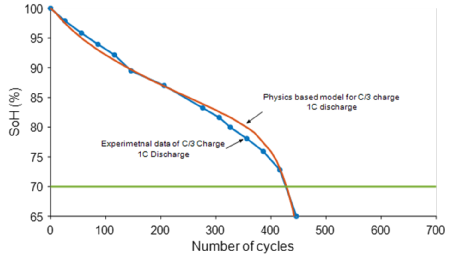
"This funding has brought the project forward by 12 months, and there is huge demand from potential customers," said Dr Umut Genc, Managing Director, Eatron Technologies. "With the funding, we've been able to immediately hire additional software engineers as well as tapping into cutting-edge battery research from the team at WMG. Ultimately, grant funding this project de-risks the activities required to achieve feasibility of this highly innovative approach to RUL estimation.
Tony Harper, Challenge Director for Faraday Battery Challenge at UK Research and Innovation, said:
“Since 2017 the Faraday Battery Challenge has been supporting the UK’s battery companies to produce batteries that are more cost effective, more efficient, charge faster and can easily be recycled. This new round of funding has enabled us to support companies, like Eatron Technologies, across the battery supply chain and build on the UK’s world class research and innovation.”
EVs on UK roads are set to see rapid growth, with 1.8 million expected to be sold in 2030, or 64% of total car sales, according to the Faraday Institution. The accompanying acceleration in battery manufacturing will drive a substantial increase in second-life applications, while the supply for stationary applications could excess 200 gigawatt-hours per year by 2030.
This rapid adoption of EVs around the world will increase global demand for BMSs over the coming years. Eatron Technologies is proud to be seen as a forerunner in BMS technology by the Faraday Institute and hopes that project COBRA plays an important role in the global fight for the environment by making EVs more practical for fleet operators and drivers around the world.
UK-based consortium established to develop prototype solid-state batteries
MOU signed between Johnson Matthey, Faraday Institution, Britishvolt, Oxford University, UK Battery Industrialisation Centre, Emerson & Renwick and University of Warwick
HARWELL, UK (19 August 2021) A consortium of seven UK-based organisations has signed a memorandum of understanding to combine ambitions to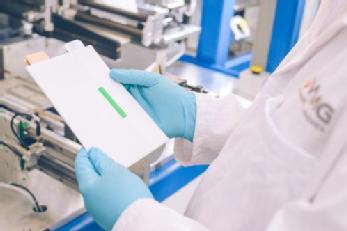 develop world-leading prototype solid-state battery technology, targeting automotive applications.
develop world-leading prototype solid-state battery technology, targeting automotive applications.
Solid-state batteries offer significant potential advantages over conventional lithium-ion batteries and could be transformational in meeting the UK’s net zero commitments through the electrification of transport. The successful outcome of the collaboration would be to harness and industrialise UK academic capability to produce cells using highly scalable manufacturing techniques that leapfrog the cost-effectiveness and performance achieved elsewhere.
The consortium comprises the following world-leading organisations in battery research, development and manufacturing:
· Faraday Institution – the UK’s independent institute for electrochemical energy storage research, which has led the consortium’s formation and will lead its development.
· Britishvolt – the UK-based Gigaplant developer, with a site in NE England.
· E+R (Emerson & Renwick) – a world leading designer of manufacturing equipment.
· Johnson Matthey – a global leader in sustainable technologies and the UK’s leading battery materials business.
· Oxford University – that leads the Faraday Institution’s solid-state battery project (SOLBAT) and provides the necessary scientific understanding to the consortium.
· UK Battery Industrialisation Centre – the pioneering battery manufacturing development facility to enable UK battery manufacturing scale-up and facilitate upskilling in the battery sector.
· WMG, University of Warwick – leaders in battery R&D and initial scale-up capability, as well as academic and apprenticeship skills development.
The preliminary design for a prototyping facility has been developed. Sources of funding are currently being sought.
Minister for Investment Lord Grimstone said: “Collaboration between industry, government and our world-leading academic institutions is putting the UK at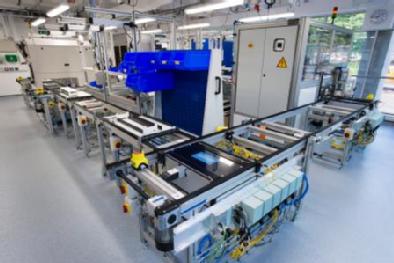 the forefront of global efforts to develop innovative automotive technologies, such as solid-state batteries.
the forefront of global efforts to develop innovative automotive technologies, such as solid-state batteries.
“It is the work of our internationally-renowned research and development base, like those brought together by this consortium, that will give us the tools needed to forge a strong and sustainable future for the automotive sector and increase our contribution to combatting climate change.”
“I am delighted to be able to announce the formation of this unique consortium for the advancement of solid-state battery prototyping that includes leading UK-based organisations at many stages in the value chain,” said Professor Pam Thomas, CEO of Faraday Institution. “Our leadership in this venture signals a move towards a role that the Faraday Institution will increasingly play as a trusted convener of significant partnerships between UK industry and academia as a route to commercialise breakthrough science emerging from our research programmes to maximise UK economic value.”
Solid-state batteries (SSBs) offer significant potential advantages over existing lithium-ion battery technologies, including the ability to hold more charge for a given volume (leading to increased electric vehicle (EV) range) and reduced costs of safety-management. Early deployment of SSBs is likely to be in consumer electronics, niche automotive applications and unmanned aerospace, before being used in broader EV markets. The Faraday Institution forecasts that, in 2030, SSBs are likely to take a 7% share of the global consumer electronics battery market and a 4% share of the EV battery market[1]. Global SSB revenues from sales to EV manufacturers are expected to reach $8 billion by 2030[2] and then grow rapidly to 2040 and 2050 when the market is expected to become extensive.
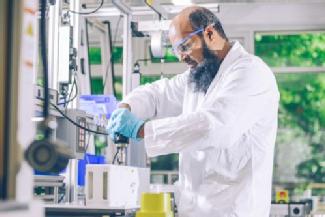 However, there are fundamental scientific challenges that need to be addressed before high power SSBs with commercially relevant performance can be realised. The Faraday Institution’s SOLBAT project has made considerable progress in addressing these challenges over the last three years.
However, there are fundamental scientific challenges that need to be addressed before high power SSBs with commercially relevant performance can be realised. The Faraday Institution’s SOLBAT project has made considerable progress in addressing these challenges over the last three years.
The construction of the one-of-a-kind facility being developed by the collaboration will enable SSB technology to emerge from UK university laboratories. It will allow larger cells to be produced using scalable manufacturing techniques that will be improved iteratively through deep investigation of the causes of problems that emerge during manufacture and testing of prototype batteries. This will leverage the collective knowledge of Faraday Institution SSB researchers and the industrial partners.
Christian Gunther, CEO, Battery Materials at Johnson Matthey comments, “The realisation of a prototype solid-state battery cell will be a great achievement for the UK battery industry, and this consortium will be a critical enabler for delivering this milestone. Delivering enhanced range and safety over traditional lithium-ion battery technologies will be a key driver for battery electric vehicle adoption, supporting the transition to a net zero future.”
Dr Allan Paterson, Chief Technology Officer, Britishvolt comments, “Solid-state is the holy grail of battery solutions. Solid-state batteries have the potential to increase energy density significantly over battery technology available today and could dramatically, and positively, change the world of electric vehicles. Britishvolt will be at the forefront of commercialising this step change over the coming years. This collaboration, which includes major global industrial leaders such as Johnson Matthey and academic leadership from University of Oxford, underscores another key objective in our technology roadmap – home grown intellectual property.”
Professor Peter Bruce, Principal Investigator of SOLBAT, comments: “It’s fantastic to see the culmination of combined UK academic strength in solid-state battery research come to fruition. I’m proud that the work of the Faraday Institution SOLBAT project, led by Oxford University, will make a significant contribution to the UK’s green energy revolution.”
Ian Whiting, Commercial Director at UKBIC added: “Our newly opened national battery manufacturing scale up facility is already contracted to scale new cells and battery packs by companies basing their manufacturing centres in the UK. It’s a really exciting time for this fast-growing industry. We’re scaling technologies that will be the core products of the UK’s emergent Gigafactories. But we need to think even further ahead and solid-state battery technology is going to be a big part of that. This collaboration is what is needed to give the UK the edge it needs in creating a centre of excellence for solid-state batteries and we’re excited to be part of it. The bringing together of academic and industrial know how in this space is key to unlocking Britain’s electrified potential.”
David Greenwood, Professor of Advanced Propulsion Systems, and CEO of WMG High Value Manufacturing Catapult comments: “Early forms of solid-state battery are already around us, but we have yet to see solutions which are both mass-manufacturable and meet the performance and cost targets for future transport applications. There remains huge opportunity for innovation in this space, and this initiative will provide the route for the UK to fast-track candidate technologies to industrialisation.”
Andrew C Jack, Sales Director, E&R Group comments, “E&R Group are delighted to be contributing our world renowned engineering expertise working in partnership Faraday and the wider consortium on this exciting development for next generation battery production for the UK.
For more information on the Faraday Institution, visit www.faraday.ac.uk and follow @FaradayInst on twitter.
Three RIBA award wins for the Prof. Lord Bhattacharyya building
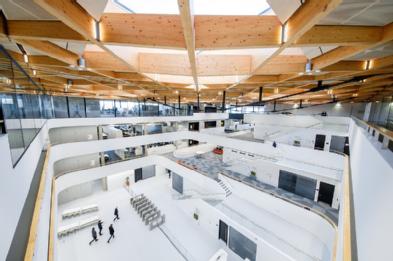 The Prof. Lord Bhattacharyya building, home to the National Automotive Innovation Centre, based at the University of Warwick, has received an impressive three awards at the RIBA West Midlands regional awards.
The Prof. Lord Bhattacharyya building, home to the National Automotive Innovation Centre, based at the University of Warwick, has received an impressive three awards at the RIBA West Midlands regional awards.
The building scooped top spot for Building of the Year, Client of the Year and the Regional Award, beating off stiff competition from across the West Midlands.
The RIBA awards champion and celebrate the best architecture in the UK and around the world, no matter the form, size or budget.
Executive Chair of WMG, Margot James comments: “I’m thrilled that the Prof. Lord Bhattacharyya Building has been recognised in this way, it is a great tribute to the late Professor Lord Bhattacharyya’s vision. Having a building that inspires designers, engineers and academics to develop the next generation of transport is excellent news for our partners and the region. The Midlands is the beating heart of automotive in the UK, and the National Automotive Innovation Centre, will be the driving force behind future innovation in transport mobility.”
James Breckon, Director of Estates, at the University of Warwick, comments: “It is great to see this new building being recognised and is testament to the wealth of architectural and engineering talent that was brought together to deliver this exemplary sustainable building. It brilliantly draws Industry and Academia together providing an inspirational environment to innovative within. As a landmark building it has transformed the campus at the University of Warwick and is a fitting legacy to the late Prof Lord Bhattacharyya.
The National Automotive Innovation Centre is a partnership between WMG, University of Warwick, Jaguar Land Rover, and Tata Motors, and is the largest of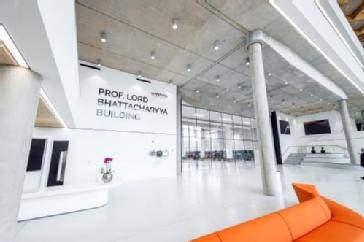 its kind in Europe and is well timed, arriving when a global mobility revolution is underway, with a new age for transport mobility.
its kind in Europe and is well timed, arriving when a global mobility revolution is underway, with a new age for transport mobility.
A beacon for automotive research it brings together the brightest minds from industry and academia, to develop future vehicles and mobility solutions. It is home to up to 1,000 staff working across design, engineering and research, as well as future engineers on degree programmes.
Designed by Cullinan Studios the brief for the Centre was for simplicity and strength of purpose, turning a complex assembly of spaces into an immediately legible building.
The National Automotive Innovation Centre is a £150m investment between WMG, Jaguar Land Rover, and Tata Motors with £29.5m funding from the UK government’s UK Research Partnership Investment Fund through Research England, which includes the development of an Advanced Propulsion Research Laboratory.
You can see all of the 2021 West Midlands RIBA award winners here: https://www.architecture.com/awards-and-competitions-landing-page/awards/riba-regional-awards/riba-west-midlands-award-winners
Synthetic diamond and AI research at Warwick to shine in new industry partnerships
§ University of Warwick is involved in two Prosperity Partnerships that will bring together expertise and insight from academia, business and industry
§ Researchers in the Departments of Physics, Chemistry and Engineering will work with Element Six on establishing a synthetic diamond supply chain to help develop new diamond-enabled technologies
§ Researchers from the Department of Computer Science and WMG at the University of Warwick involved in developing a Framework for responsible adoption of Artificial Intelligence in the financial services industry
Projects that will combine the expertise and insight of University of Warwick researchers with that of business and industry to further developments in diamond-enabled technologies and to develop a Framework for responsible adoption of Artificial Intelligence in the financial services industry have received national funding.
diamond-enabled technologies and to develop a Framework for responsible adoption of Artificial Intelligence in the financial services industry have received national funding.
They are announced today (22 July) among eight business-led Prosperity Partnerships in support of the government’s ambitious new Innovation Strategy.
They are supported with an investment of almost £60 million by the Engineering and Physical Sciences Research Council (EPSRC), part of UK Research and Innovation (UKRI), businesses and universities.
Prosperity Partnerships build on existing UK strengths in industry and academia to develop new technologies, processes, and skills that will deliver economic growth and create jobs across the UK.
At the University of Warwick, researchers will establish a supply chain of synthetic diamonds to help develop new technologies, as well as developing a Framework for responsible adoption of Artificial Intelligence in the financial services industry, in projects that will see them collaborate closely with business and industry.
Diamond is one of the most versatile materials on earth, with applications in thermal, optical, sensing, electrochemistry and quantum.
The world we live in today presents a variety of technical challenges, each associated to different industrial applications, such as thermal management bottlenecks in internet and telecommunication infrastructures, as well as industrial wastewater management and disposal. Over the last few years’ diamond has been recognised as a reliable solution in many of these fields, while also unlocking novel applications in quantum technology as well as material machining and welding using high power lasers.
The £5.2 million project, a partnership between the Departments of Physics, Chemistry and Engineering at the University of Warwick and Element Six, aims to establish a supply chain for these vital technologies, which will help researchers and businesses to capitalise on the potential of high quality, engineered synthetic diamonds to deliver new, disruptive solutions across a range of industries, including semiconductors, water technology and quantum.
Professor Mark Newton, of the University of Warwick Department of Physics, said: “The project outcomes will include new materials with improved and tailored properties, new science enabled by enhanced properties and the ability to manufacture innovative diamond devices.”
Dr Daniel Twitchen, Chief Technologist at Element Six said: “Leveraging nearly 20 years of successful collaboration, ranging from fundamental science to commercialised applications, our partnership with the University of Warwick aims to build on the UK’s world-leading role in this field, alongside Element Six’s renowned expertise and capabilities in advanced material solutions, to develop the next generation of diamond-enabled technologies.”
Researchers from WMG at the University of Warwick and the Department of Computer Science are also involved in a project that will see The Alan Turing Institute, HSBC, and other organisations in the financial sector, developing a Framework for responsible adoption of Artificial Intelligence in the financial services industry (FAIR).
This Prosperity Partnership project aims to develop the trustworthy, data-driven AI decision-making approaches that are needed for the wider adoption of these technologies in the financial and professional services sector, which employs 2.2 million people and has an estimated total value of £190 billion. The University will lead the work on security and privacy issues in AI deployment in financial services. Professor Carsten Maple leads the EPSRC-NCSC Academic Centre of Excellence in Cyber Security Research and is a member of the Royal Society working group on Privacy Enhancing Technologies and Professor Graham Cormode is Fellow of the ACM and an award winning researcher for his work in privacy and data analytics.
Professor Maple said: “With the increasing deployment of AI it is vital that the systems and their inferences are secure and respect the privacy needs of citizens and businesses. We are proud to work with such an outstanding group of researchers and organisations to deliver a project that provides the fundamental research that can transform the sector and place the UK at the global forefront.”
EPSRC Executive Chair Professor Dame Lynn Gladden said: “Artificial intelligence, digital chemistry and digital twins are some of the new and transformative technologies that will help to drive the Net Zero revolution, address major societal challenges, and deliver prosperity to the UK.
“By bringing together UK businesses and universities, these new Prosperity Partnerships will generate the knowledge and innovations that will enable these cutting-edge technologies to realise their transformative potential across a diverse range of sectors.”
§ Read the EPSRC’s press release at: https://www.ukri.org/news/intelligent-road-repairs-among-eight-new-prosperity-partnerships/
Ends
Notes to editors:
Image for the Element Six/University of Warwick diamond project available at: https://warwick.ac.uk/services/communications/medialibrary/images/july_2021/prosperity-partnership.jpg
Caption: Laser light shining through Element Six’s NV diamond – Copyright of Element Six
Project summaries:
Element Six and University of Warwick
Diamond is the epitome of a multi-functional material with applications in thermal management, optical transmission, electrochemistry, and quantum technologies. Engineered synthetic diamonds offer an extraordinary combination of extreme properties and are capable of meeting the needs of the most demanding of applications in these diverse fields. The partnership aims to build on the UK’s world-leading role in diamond growth and exploitation to develop diamond solutions in areas where conventional materials are increasingly unable to meet the performance levels required by new technologies. We will establish a UK diamond technology supply chain which will help researchers and businesses to capitalise on the potential of high quality, tailor-made synthetic diamonds to develop next-generation solutions to real-world challenges.
HSBC and The Alan Turing Institute
AI technologies have the potential to unlock significant growth for the UK financial services sector through:
§ novel personalised products and services
§ improved cost-efficiency
§ increased consumer confidence
§ more effective management of financial, systemic, and security risks.
The partnership aims to develop the trustworthy, data-driven AI decision-making approaches that are needed for the wider adoption of these technologies.
It aims to address challenges such as how to increase the accuracy of predictive models without threatening fair treatment of all customers or improving transparency without leaving systems open to external threats.
It aims to outline how the finance sector can make the transformational shift to the greater use of AI technologies and ensure that these technologies have fairness, security and accountability at their heart. Whilst also, being robust and aware of privacy.
22 July 2021
WMG Visualisation Engineers use VR to help recreate experience of Medieval Coventry Weaver’s House during Coventry’s year as UK City of Culture
Coventry is not only famed for its Cathedral, two tone music and the automotive industry, it is also famous for its weaving, in fact the medieval Weaver’s House still stands as an attraction today in Coventry’s Spon Street. In 1540 John Croke and his family would have been making cloth on a wooden loom in the Weaver’s House, and whilst you can go to the house, the opportunity to experience the home exactly how it would have been for John and his family is now possible, thanks to visualisation engineering researchers from WMG at the University of Warwick.
House still stands as an attraction today in Coventry’s Spon Street. In 1540 John Croke and his family would have been making cloth on a wooden loom in the Weaver’s House, and whilst you can go to the house, the opportunity to experience the home exactly how it would have been for John and his family is now possible, thanks to visualisation engineering researchers from WMG at the University of Warwick.
Using Virtual Reality WMG's Professor Alan Chalmers (Professor of Visualisation at the International Digital Laboratory, WMG, University of Warwick) and his students have recreated a walkthrough of the medieval Weaver's House in Spon Street, the movement and skill of operating the loom was captured using Microsoft Kinect V2 cameras against a green screen, before being extracted and put onto a screen with a realistic background created. The addition of candles adds to the complexity of the process but makes the scene a more accurate portrayal of the living and working conditions.
It is part of a free exhibition called ‘Metropolis’ just opened at the newly refurbished and renamed Metropolis restaurant in Coventry (formerly Drapers' Bar), an exhibition that explores the story of Coventry through its building. The exhibition is running during Coventry’s year as UK City of Culture.
The exhibition’s curators, Sabine Coady Schäbitz and Mark Webb weave medieval and modern stories together in five themes: movement, enterprise, culture, resilience and the future. It celebrates Coventry’s distinct contribution to the history of the built environment in Britain, from industrial premises including workshops and factories, to major religious buildings containing some of the finest decorative art in the country.
Professor Alan Chalmers, from WMG, University of Warwick comments:
“My team and I are really pleased to be a part of this exhibition and especially to demonstrate our new technology that recreates on screen an authentic portrayal of the skills of medieval weaving, an industry that was so vital to the city’s makers reputation and prosperity in the 16th century.
“We were delighted to be working with charity Medieval Coventry and be funded by the Institute of Engagement's Community Partnership Fund with support and guidance in making the results of our research accessible to the public.”
There are plans to take the exhibit on a tour of local schools in 2022 and produce an extended multisensory display in the Herbert Museum's Medieval Gallery that will include other local skills such as dyeing and tanning.
This isn’t the only contribution the University is making for the exhibition, as after many months exploring the film archives to discover the story of the city's architecture, Film Television Studies PhD student Kat Pearson looks at Coventrians’ relationship with the built environment in her film.
Kat collaborated with The Media Archive for Central England (MACE) on creating a series of short archive films drawing on gems from the MACE collection. Along with Archivist Philip Leach they have brought together items which highlight the relationship between Coventry's communities and its buildings in the latter half of the 20th Century.
PhD researcher Kat Pearson from the Department of Film and Television Studies at the University of Warwick comments:
“This is a topic that I have a personal interest in and researching these films has been an amazing opportunity for me to look at the architecture of Coventry in a new light. The Metropolis exhibition allows us to showcase some wonderful archival films in a public space, and this builds on a project in 2020 to bring archival films to the Foleshill community.”
Further information on Kat's work in Foleshill can be found here: https://warwick.ac.uk/fac/arts/film/tvhistories/blog/foleshillscreenings
Exhibition details:
Metropolis: Coventry’s medieval and modernist ambitions
Free (10am-6pm daily)
1st Floor of Metropolis, Earl Street, Coventry CV1 5QP
For further information please contact:
Peter Dunn, Director of Press and Media Relations:
Mobile: 07767 655860 Email p.j.dunn@warwick.ac.uk
PJD 20th July 2021
WMG Associate Professor partners with leading health-tech company
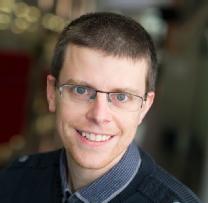 WMG’s Associate Professor Mark Elliott will be working alongside health tech experts at EQL, in a two year part-time secondment, focusing on the impact of digital health technology.
WMG’s Associate Professor Mark Elliott will be working alongside health tech experts at EQL, in a two year part-time secondment, focusing on the impact of digital health technology.
Dr Elliott was awarded funding through the UKRI Innovation Scholars Secondment: Biomedical Science scheme which aims to intensify knowledge exchange between industry and academia.
Dr Elliott explained: “I’m looking forward to working closely with the team at EQL. My previous research has always been on the academic side so this will give me a real insight into a fast-growing health-tech company and how they operate.
“The aim of the secondment is to support EQL in evaluating and validating their platforms using rigorous research methods, whilst also gaining knowledge of the state-of-the-art technologies that EQL use to support people with their musculoskeletal health; it’s a really exciting opportunity.”
Dr Elliott is based at the Institute of Digital Healthcare at WMG, University of Warwick with his core research focusing on human movement analytics, using signal processing and data science approaches to monitor, measure and model movement in a range of different contexts. He is particularly interested in the self-management of physiotherapy, highlighting it as one of the big challenges in healthcare at the moment.
His role on the secondment is to undertake research into how digital applications of technology can support people to self-manage their musculoskeletal health. The focus will be on implementing remote management and digital health platforms that could incorporate a number of technologies such as chat bots. He will initially work in the R&D team to investigate methods to collect clinical information through smartphone applications as well as exploring other novel uses of consumer grade technology.
He added: “On the research side it’s really useful to understand how people can use digital platforms — how they engage with them and for how long, whether they find it useful and whether it improves the long-term outcomes of patients.”
Find out more about at the Institute of Digital Healthcare here.
First International safety standard for fully automated driving systems has been published
§ One of the first applications of Level 4 autonomous vehicles is expected to be low speed automated driving (LSAD) systems, such as pods
§ However, lack of safety standards has hampered their commercial deployment on public roads
§ An international group of experts led by WMG, University of Warwick working together as a part of an ISO technical committee, has published the first international (ISO) safety standard for level 4 automated driving systems, taking them a step further towards being more widely available
· This new ISO standard could enable an environmentally-friendly transport option, as well as a solution for people with mobility issues.
The use of low speed automated driving systems can contribute to reduction of congestion and carbon emissions all over the world, however the enrolment of such systems has been hampered by the lack of safety standards, until now; as an international group of experts led by WMG, University of Warwick working as part of an ISO technical committee have published the first international safety standard for level 4 automated driving systems.
Low speed automated driving (LSAD) systems, such as the autonomous pods are classed as a level 4 automated driving systems. They provide an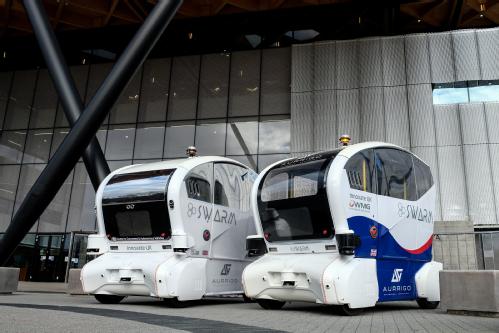 opportunity for cities to reduce congestion and carbon emissions, thus contributing to net-zero targets.
opportunity for cities to reduce congestion and carbon emissions, thus contributing to net-zero targets.
They currently tend to operate on predefined routes in low-speed environments, often being used in commercial, business or university campuses. Yet growth in this area has been hampered by a lack of international standards that define minimum performance and safety requirements to be met.
However, the first international safety standard for a level 4 automated driving systems has just been published by ISO (International Organization for Standardization) to help accelerate its progress in a safe and sustainable way.
The standard, ISO 22737, ‘Intelligent transport systems — Low-speed automated driving (LSAD) systems for predefined routes — Performance requirements, system requirements and performance test procedures’ was developed by an international group of experts led by Dr Siddartha Khastgir from WMG, University of Warwick, UK.
In the ISO 22737 standard, the group have set out the specific minimum safety and performance requirements for LSAD systems, providing a common language to help facilitate the development and safe deployment of this technology worldwide. The group included experts from Japan, USA, Canada, Australia, South Korea, China, Germany, France, the Netherlands, Hungary and the UK.
This standardization activity is underpinned by strong research outcomes from the CCAV and Innovate UK funded INTACT research project by WMG and Aurrigo; and also by the research conducted as part of Dr Khastgir’s UKRI Future Leaders Fellowship.
Dr Siddartha Khastgir, from WMG, University of Warwick who served as the Project Leader of the group of experts that developed the ISO standard, stated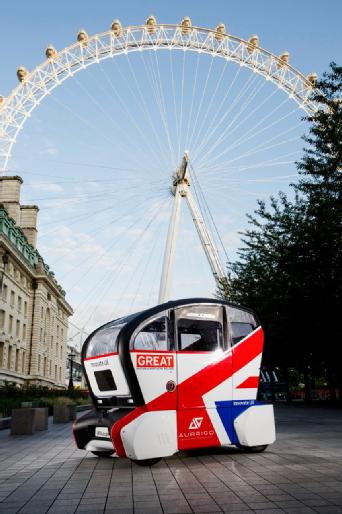 that:
that:
“An increased use in LSAD systems can lead to a shift in the way people, goods and services are transported. This new standard will enable the safe deployment of an environmentally-friendly transport option, as well as a solution for people with mobility issues."
Some of the key points from the new standard include:
· Providing minimum operating capabilities for LSAD systems including guidance on Operational Design Domain (ODD) definition· Guidance on how LSAD systems may fit into the wider transport ecosystem
· Performance requirements for different aspects of the LSAD system such Dynamic Driving Task; Emergency maneuvers (e.g. emergency stop and minimal risk maneuvers); hazardous situation identification; static and dynamic obstacle detection and avoidance
· Test procedures for various system functionalities
Simon Brewerton, Chief Technology Officer at Aurrigo Driverless Technology, a Coventry based LSAD system manufacturer comments:
“Aurrigo is one of only a couple of UK based vehicle OEMs who produce low speed autonomous vehicles. These vehicles are engineered in the UK but are deployed globally. It had been increasing difficult to communicate the level of safety engineering that our vehicles encompass, and also difficult to compare various attributes and functionality against the perceived state of the art for this class of vehicle.
“Aurrigo decided to invest our resources and domain knowledge following an invitation from WMG to bring an OEM viewpoint to the BSI working group for the ISO22737 LSAD standard. Working closely with Siddartha, Aurrigo had the opportunity to share the experiences gained from many deployments globally, and provide insight into the practicalities of building a suitable test regime.
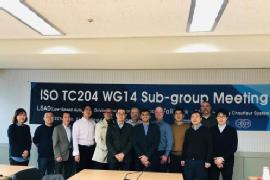 “The new LSAD standard puts a line in the sand for all OEMs to exceed and so enables a global market where all players rise to the same exacting standards as each other, keeping the public safe and the industry competitive.”
“The new LSAD standard puts a line in the sand for all OEMs to exceed and so enables a global market where all players rise to the same exacting standards as each other, keeping the public safe and the industry competitive.”
Nick Fleming, Head of Sector, Transport and Mobility, British Standards Institution mentioned:“BSI, the UK’s National Standards Body, would like to recognise the work of our technical committee (EPL/278) and UK experts that have fed into the development of this important standard, the first international (ISO) standard for Low-Speed Autonomous Driving (LSAD) systems. BS ISO 22737 is an important development in the evolving landscape for automated vehicle standards, much like BSI’s PAS 1883 an ODD (Operational Design Domain) taxonomy for Automated Driving Systems authored by Siddartha and published in 2020, in helping support safe trialing and operation of automated vehicles.”
UKRI Future Leaders Fellowships Director Stephen Meader said:
“The publication of the first International safety standard for fully autonomous vehicles represents a major step towards the widespread adoption of a more environmentally friendly mode of transport that can cut both congestion and carbon emissions. In the year of COP26, this kind of innovation has never been more important.
“The work of Dr Khastgir and his team demonstrates the value of Future Leaders Fellowships funding to support talented researchers and innovators to deliver change that can be felt across society and the economy.”
ISO 22737 was developed by ISO technical committee ISO/TC 204 Intelligent transport systems, whose secretariat is held by ANSI, the ISO member for the USA.
It can be purchased from your national ISO member or through the ISO Store.
ENDS
8 JULY 2021
NOTES TO EDITORS
Dr Siddartha Khastgir is the recipient £1.2 million UKRI Future Leader Fellow which focusses on evaluating the safety of Autonomous Vehicles by scenario generation and use of simulation-based testing. See more: https://warwick.ac.uk/fac/sci/wmg/research/cav/vandv/ukriflf/
High-res images available at:
https://warwick.ac.uk/services/communications/medialibrary/images/july_2021/img_0022_-2.jpeg
Caption: Some members of the drafting team of ISO 22737. Experts from Japan, USA, South Korea, Canada, Australia and the UK
Credit: WMG, University of Warwick
https://warwick.ac.uk/services/communications/medialibrary/images/january2020/xt2a0019.jpg
Caption: Aurrigo Autonomous pods outside the Professor Lord Bhattacharyya building, University of Warwick
Credit: WMG, University of Warwick
https://warwick.ac.uk/services/communications/medialibrary/images/july_2021/1.jpg
Caption: Aurrigo Autonomous pod on a pedestrian street
Credit: Aurrigo Driverless Technology
https://warwick.ac.uk/services/communications/medialibrary/images/july_2021/2.jpg
Caption: Aurrigo Autonomous pod on a pedestrian street
Credit: WMG, University of Warwick
https://warwick.ac.uk/services/communications/medialibrary/images/july_2021/7.jpg
Caption: Aurrigo Autonomous pod on a pedestrian street
Credit: Aurrigo Driverless Technology
https://warwick.ac.uk/services/communications/medialibrary/images/july_2021/3.jpg
Caption: Aurrigo Autonomous pod
Credit: Aurrigo Driverless Technology
ISO 22737: https://www.iso.org/standard/73767.html
For further information please contact:
Alice Scott
Media Relations Manager – Science
University of Warwick
Tel: +44 (0) 7920 531 221
E-mail: alice.j.scott@warwick.ac.uk
